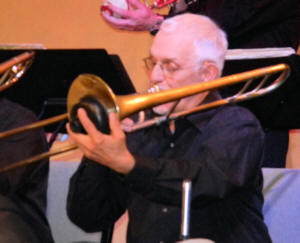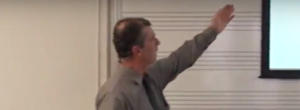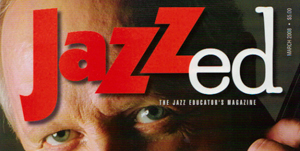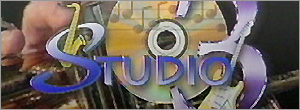NAME: Richard Arnold Stepton, AKA Rick Stepton
DOB: February 28, 1942
Parents: Lawrence Edson Stepton and Beatrice Estelle Teto
Instrument: Trombone
Education: Berklee College of Music (1966-‘68)
Private Instruction: Lawrence Stepton, Sr. (grandfather) and Phil Wilson
Awards: 1998 Lifetime Achievement Award in Jazz by the Massachusetts Chapter of the International Association of Jazz Educators
Local Playing Experience: The Fitchburg High School Dance Band and Marching Band, the Ashby Band, the Fitchburg Band, the Fitchburg Military Band, Leominster (Italian) Colonial Band, the Five Knights of Rhythm (father’s Dixieland band), High School Trio with Don Healy and Mike Hooper, The Worcester Jazz Orchestra, as well as gigs with Mark Marquis, Jane Miller, Emil Haddad, Dick Odgren, and Rockie Blunt.
Regional Playing Experience: Bruce Stevens, Dean Hudson, and Buddy Bair (regional territory bands -- 62-66)
National and International Playing Experience: 118th Army Band, Jimmy Dorsey Orchestra (led by Lee Castle -- 1966), Buddy Rich – off and on from 1968-’86), as well as bands led by Harry James (ghost band), Woody Herman, Maynard Ferguson, Chuck Mangione, Gunther Schuller, Herb Pomeroy, Greg Hopkins, Ken Hadley, Rick Henley, Dan Gabel, John Allmark, Joe Elefante, Chico and Arturo O’Farrill, and Richie Cole. Stepton was also a band member of Lighthouse, the Phil Nimmons Orchestra, the Pratt Brothers Big Band, White Heat Swing Orchestra, Hal McIntyre Orchestra, and Orange Then Blue. A partial of list of performers he has supported include Stevie Wonder, Aretha Franklin, Ray Charles, Natalie Cole, Harry Connick, Jr., Roberta Gambarini, Lena Horne, Mel Torme, Tony Bennett, and Ella Fitzgerald, Lou Rawls, Sarah Vaughan, Peggy Lee, and Nancy Wilson. The list of stars he has worked with exceeds 250.
Tours: Virtually every U.S. state, Canada, Europe, Mexico, South America and the Far East
Highlights: Command Performance for the Queen of England, Jimmy Carter Inauguration, and at such esteemed venues as the Newport, Monterey, and Montreal jazz festivals
Television shows: “Ed Sullivan,” “Johnny Carson,” “Nightline,” “Mike Douglas”
Filmography: Dick Tracy, Meet Joe Black, Calle 54
Select discography: (Appears on more than 50 albums) Mercy, Mercy, Mercy, Buddy Rich; Plays and Plays, Buddy Rich; The Raven Speaks, Woody Herman; Can You Feel It, Lighthouse; Atlantic Suite, Phil Nimmons Orchestra; Jazz Profile, Art Pepper; A Beautiful Friendship, Rebecca Parris; Rises’ Rose Garden, Richie Cole; Casa Corazon, Mili Bermejo; While You Were Out, Orange Then Blue; Jumpin’ in the Future, Gunther Schuller
As a leader: Inspiration (1996); Blue Collar (1996, 1997); Stiff Upper Lip (1999)
See:
http://www.discogs.com/search?type=all&q=Rick+Stepton
http://www.allmusic.com/artist/rick-stepton-mn0000302737/credits
Compositions: Stepton has written closed to 50 pieces. In speaking of “This One’s for Buddy Rich,” the trombonist said, “[Playing in Buddy Rich’s band] was a wicked eye-opener. It was the power of it. The level of performance was so much higher than anything I’d ever been around. And Buddy was a magnetic force.”
Press Quotes: “Stepton ranges from a dark, burry, funky attack that could be a cross between Bill Harris and Jack Teagarden and a soaring, slippery vibrato that is reminiscent of some of Phil Wilson’s work with Woody Herman. Stepton has a fascinating array of colors and accents. – John S. Wilson, the New York Times
Rick Stepton, Sliding Into View
Written By: Chet Williamson
He is the son of a son of a trombone player. Yes, a third-generation sackbut slider who at an early age fell in love with the low-voiced brass horn. Six decades later, Stepton continues to carry a deep passion for the instrument, one that has taken him around the world.
His grandfather, Lawrence Edson Stepton, Sr., was the first generation player in the family’s trombone lineage. “He was my first teacher and a great teacher,” Stepton said. “He loved Tommy Dorsey. [The senior Stepton] taught my father how to play and then when I slid into view …. I started playing in 1950 when I was eight years-old. It was part of my family. We listened to big band records at home.”
Stepton grew up at 37 Davis Street in Fitchburg, MA. He was born on Daniels Hill in the Cleghorn or French-Canadian section of town at 12 Dumais Street and went to grammar school at Academy Elementary, middle school at B.F. Brown and later Fitchburg High School Growing up, music was as pervasive as wallpaper in the Stepton household.
See: http://en.wikipedia.org/wiki/Fitchburg,_Massachusetts
Speaking about his grandfather, Stepton said, “He was a good trombone player. He came from England and went to New York in the 1920s.”
Of his father, Stepton recalled, “My dad was a good trombone player, but he had to quit. He was a nervous wreck. He just couldn’t handle the upper register.”
Before Rick “slid into view,” the Stepton trombones basically played in the many and varied marching bands that were common throughout the north Worcester County area in the first half of the 20th century into the 1960s.
"In my family, the trombone was holy," Stepton told Worcester Telegram & Gazette reporter Scott McLennan. "There were always great things expected of me unfairly. From the time that I was about seven years old, it was always assumed that I was going to be something special long before I thought that I might be someday. And I still don't think I am."
Fitchburg Days, Trombone Town
Stepton paid many dues and wore out countless shoes marching in the tradition of these bands. He names the Ashby Band, the Fitchburg Military Band and the Leominster (Italian) Colonial Band, especially. The venerated ensemble was founded in San Giovanni, Italy more than 100 years ago.
The active young trombonist could also be found among the various school bands.
“They were like Souza bands -- concert bands or town bands,” Stepton explained.
When I was 16, I decided that I was going to join the union and become a professional musician. I remember my first summer I made $275 playing -- $5 concerts and $3 parades. It was a sizeable chunk of change in those days.”
It should be noted that the North County region also produced two other notable trombonists as well – Al “Miff” George (one of Lawrence Stepton’s students) and Steve Piermarini (still active in the area). George worked with Bunny Berigan and Piermarini worked with Nelson Riddle, the Harry James, and the Jimmy Dorsey orchestras.
Stepton was an active kid in high school as his yearbook points out. In addition to playing basketball, football and running track, the young trombonist was busy in all aspects of music. He also quoted the German philosopher Friedrich Nietzsche saying, “Without music life would be a mistake.” Stepton was a living testament to the old saying. He played in the school’s marching band, concert band, orchestra, brass choir, and dance band. He especially remembers band director Ed Hanson as a supportive teacher.
“In high school I was really into jazz,” he said. “I was cool.” The trombonist recalls writing a composition in English class on the history of jazz. The teacher gave him the grade of C. “She said, ‘I would have received an A if it weren’t for the poor subject matter.’”
Military, Territory Bands, and the Road
After high school, Stepton dreamed of enrolling in the New England Conservatory, but the family could not afford it. “College? Not a given,” Stepton said. “[My] folks couldn’t afford it so I had to go into the Army. We were financially challenged. We were poor as church mice.”
In the military, Stepton played in the 118th Army Band and recalls playing with jazz ensembles while stationed in France. He was discharged in 1962 and for the next five years hit the road touring with territory bands around the county, playing with groups led by Bruce Stevens, Buddy Bair and Dean Hudson.
With Bair, Stepton toured the Deep South on a “Pink Sleeper” bus at the height of segregation struggles. The group played Memphis, Chicago and New York at the Roseland Ballroom where they were broadcast nationally over CBS radio. See:
See: http://www.crabapplesound.com/bb-group.htm
http://www.old-time.com/mp3s/buddy_bair63.mp3
According to music writer Christopher Popa, Dean Hudson was “a trumpeter and singer whose band originated at the University of Florida, where he and some fellow musicians had performed as the "Clubmen," first under the leadership of Eli Katz, who used a made-up name, "Dean Hudson," which had been selected in a contest.” The group was known as the “Moon Over Miami” band, that was as Stepton called it “like a farm team” for the name big bands of the day.
With these territory bands (and others), Stepton recalls traveling 5-600 miles a day through the “bible belt,” the “grain belt,” all around the country, on rickety old buses from gig to gig in pursuit of the music.
Today, in a career that has spanned more than 50 years, Stepton has toured the globe with the best Big Bands in the world. He has appeared on the Johnny Carson and Ed Sullivan television shows, has made several appearances on BBC-TV and Jazz Radio Canada, and performed at the Newport, Monterey and Montreal Jazz festivals.
Stepton earned his stripes with Buddy Rich, who called him the best lead trombonist he ever had in his band. And he was recently listed by Digital Dream Door as one of the 100 greatest jazz trombonists ever to play the instrument. See: http://www.digitaldreamdoor.com/pages/best_jazz/best_jazztromb.html
Buddy Rich
In 1966, after five years of barnstorming, Stepton felt he needed more education in his development as a jazz artist and pulled off the road. Utilizing the G.I. Bill, he enrolled in Berklee College of Music where he studied with the legendary teacher and trombonist Phil Wilson.
After two years of study, Wilson recommended Rick to fill an opening in the Buddy Rich Band. Stepton would be found playing musical chairs in and out of the band from 1968 to 1986.
In an interview with the Worcester Telegram & Gazette, Stepton spoke of his tenure. "It was great. [Rich was] probably at the top of his career. He was as good as it gets.It was like being in the pop business and being with Frank Sinatra or Barbra Streisand. It was like the jazz equivalent of being the principal trombone player in the Boston Symphony."
It should be noted that in 1970, Stepton ranked 11th in Down Beat Reader’s Poll.
As everyone knows, Rich was a notorious task master who went through an army of musicians. Stepton says he and Rich remained friends through all the changes.
"When I went back to help him out in 1986, he was so gracious," said Stepton. See: T&G. Rich also held Stepton’s trombone playing in the highest regard.
In speaking of Rich’s famous volatile temperament, Stepton said, “I never tried to analyze it. I just react to people. As a leader, I found him compassionate, human, and understanding. He showed me so much respect – very demanding though. Buddy’s a consummate performer. He never gives up. He always gives everything of himself, and expects that of everyone around him.”
During Stepton’s stint in the Buddy Rich band, the horn section alone featured such star players as Ernie Watts, Art Pepper, Richie Cole, Bob Mintzer, Don Menza.
Woody Herman
After two and a half years of the second stay with Rich, Stepton left to join Woody Herman and his Thundering Herd. JazzTimes reporter Jack Sohmer caught the band live and submitted this review of the show, which was released as Blues in the Night for Hitchcock Media Records.
“Although not as star-studded as many of Herman's earlier bands, the April 1971 edition heard at this Clearwater, FL concert is certainly deserving of attention. Of primary interest are the soloists Sal Nistico, trumpeters Bob Agnew, Tony Klatka and Buddy Powers, and trombonists Bobby Burgess and Rick Stepton.
“The program includes such largely Alan Broadbent-written charts as ‘Keep on Keepin' On,’ ‘Adam's Apple,’ the 14-minute ‘Blues in the Night,’ ‘25 or 6 to 4,’ ‘Love in Silent Amber,’ the almost 17-minute ‘Variations on a Scene’ and the classic ‘Bijou.’” See: JazzTimes, September 2000
Stepton also appears on the great Herman releases, Raven Speaks, that features pianist Harold Danko, guitarist Pat Martino, and drummer Joe LaBarbara; and The Newport Jazz Festival 1972, a date that featured such legendary guests as Zoot Sims, Stan Getz, and Al Cohn.
Lighthouse
After 18 months with Herman, Stepton again grew restless and headed for Canada, where he became a member of the group, Lighthouse. Formed in the late ‘60s, Lighthouse was a quasi-jazz-rock band that melded together a variety of music for their winning sound. Stepton says they were a horn-band like Blood, Sweat, and Tears or Chicago. For three years running in the early ‘70s they were voted the Best Canadian Group of the Year, and received Juno Awards for their efforts. Stepton remained with the group for two years, recorded two albums and toured into Hawaii.
See: http://www.canadianclassicrock.com/roster/lighthouse.shtml
See: http://www.lighthouserockson.com/history.html
Next up for Stepton, while still living in Toronto, was a brief stay in the Phil Nimmons group. In 1975, Stepton recorded Nimmons’ award-winning composition, The Atlantic Suite with the bandleader, who is known as the dean of Canadian jazz.
Maynard Ferguson
In 1976, Stepton returned stateside after a brief tour in the Maynard Ferguson Band.
Joking about the bandleader’s flighty personality, Stepton said, “Maynard has a very deep mind. Conversing with him was a real challenge. Whenever I talked with him, I could never find the ’1’ [as in the downbeat].”
See: http://www.youtube.com/watch?v=ZKWPMnkw25M
Rich Return
According to music writer Frank McGowan, the gig with Ferguson only lasted six months. “At a double billing date with Buddy Rich in Columbus, Ohio, his former boss asked him when he was going to rejoin his band. Stepton rejoined Rich shortly thereafter, helping to form the nucleus of what was to become known as the Killer Force.”
Unfortunately, in 1977 after only a year and a half with the band, Stepton was forced to leave the band because of a misdiagnosis of leukemia, which turned out to be the similar symptoms of mononucleosis.
“It was one of the greatest bands of all time,” Stepton said. “No band was ever tighter, or swung harder.”
See: http://www.youtube.com/watch?v=_575qr30slg
Boston, Berklee and NEC
After his recovery from mono, Stepton took a teaching position at Berklee, where he taught for the next four years. He was also a member of the New England Conservatory of Music jazz faculty.
“How's that for some dramatic irony? I couldn't afford to go there (NEC) but I taught there without a degree," said Stepton. He said his 15 years on the road were considered something of an equivalency degree. "So I have a PhD in the School of Hard Knocks.” See: T&G, McLennan.
As for his own education, Stepton said, “I’m pretty much self-taught. Autodidact. I learn by osmosis and emulation. I don’t believe in imitation. Imitation is the sincerest form of flattery to those that are being imitated. I believe in absorption, immersion, and letting yourself go.”
Viewing himself mainly as a professional trombone player, Stepton stepped away from academic teaching. “I felt trapped by the classroom and I left,” he said. “I'm basically a full-time performer.”
An attempt to rekindle the flame, Stepton was re-enlisted by Rich in 1982, but the old group just couldn’t catch fire.
“My head wasn’t into it,” Stepton said. “Too much had changed for both of us.” For more, see: http://www.mikejamesjazz.com/br_clips.html
Throughout the 1980s and into the early ‘90s, while living and teaching in Boston, Stepton freelanced around New England in a variety of ensembles. (In 1985, Stepton played at Becker Junior College as part of the second annual Jazz Worcester Festival.) One of the most notable bands of the period was the Wayne Naus and Rick Stepton Big Band.
See: https://www.proquest.com/docview/294322298?sourcetype=Newspapers
Stepton also gigged with the Boston Jazz Orchestra, the Kenny Hadley Big Band, and Orange Then Blue, among many others. See: http://www.georgeschuller.net/orangethen.htm
Lip Service
In 1992, Stepton took part in a historic concert in Worcester billed as a Saxtrum Club reunion. That same year, Stepton’s illustrious musical career almost ended when he was viciously attacked by a neighbor’s dog that nearly bit off the trombonist’s lip. “My lip was virtually amputated,” Stepton said. “It was hanging by....a thread of skin. If I hadn't held my hand to my lip going to the emergency room, it would have (fallen) off."
Reconstructive surgery took hours and more than 200 stitches to reattach his lip.
Redeveloping his embouchure would be another story.
"I wasn't told at the time but the doctor believed that my career was over,” Stepton said. “It was questionable whether I would ever play again.” But he did continue playing through perseverance, and his New England stubbornness.
With his career on the line, Stepton worked diligently to recover and miraculously, after only three months of playing he started to play the trombone again. See: T&G, McLennan.
The recovery process was slow and arduous, but through it all Stepton was determined to return to his world-class form.
The Big Apple
In 1998, feeling back on his game -- after 21 years of living in Boston -- Stepton decided to move to New York City, to retest his meddle in “the Jazz Mecca.”
His reputation preceded him. He quickly became a first call trombonist through the Manhattan and New Jersey scene, regularly featured with Chico O’Farrill’s Afro Cuban Jazz Orchestra, the Charles Mingus Big Band, Tom Harrell, and Richie Cole’s Alto Madness, among others.
All the while finding time to return to the Worcester area, Stepton appeared at Mechanics Hall in 1997 and the Jazz at Sunset series in 1998 with tenor saxophonist Steve Marcus. That year also saw the release of Stepton’s award-winning Worcester-based Brownstone label album, Stiff Upper Lip. In reviewing the disc, music critic Patricia Myers said: “Trombonist Rick Stepton obviously has a droll sense of humor, writing a song called "Stiff Upper Lip" and dedicating it to the plastic surgeon that repaired facial injuries from a 1992 dog attack. The New York musician also has excellent musical taste, selecting trumpeter Herb Pomeroy and saxophonist Steve Marcus (both colleagues from his Buddy Rich years) to create a fiery front line for his second album.
“This three-horn format cooks from start (Roland Kirk's "Serenade to a Cuckoo") to finish (three Stepton originals). They trade fours and eights, agilely adapting to each other's riffs with infectious excitement. Their reading of Duke Jordan's tribute to Art Blakey, "No Problem," is an inventive samba that involves John Wilkins' fluent guitar. Bronek Suchanek's resonant bass enriches "Dreamcatcher" and the title track, two of four Stepton originals. Drummer Bob Gullotti, although more known for avant garde outings, is a straight-ahead propellant.” See: JazzTimes, May 2000
Back Home Again
In 2007, at the age of 65, after nine years in the New York area, Stepton returned to New England. “I got homesick,” Stepton quipped. It wasn’t long before the word got out to local musicians, and the trombonist was seen around town with the Worcester Jazz Orchestra as well has with bands throughout the Greater Boston area.
In 2009, Stepton appeared on the Hanover Theatre stage in the trombone section of a Las Vegas-based show called the Rat Pack is Back. He was also in performance at Foxwoods, appearing in the orchestra supporting the Don Rickles and Joan Rivers Show.
In 2010, Stepton’s career once again nearly ended when he was diagnosed with bladder cancer. “I didn’t feel bad or good, I just accepted it,” he said.
After months of chemotherapy, Stepton was given a clean bill of health.
See: Fitchburg Sentinel & Enterprise, January 10, 2011
As of this writing, Stepton takes it one day at a time, playing the music he loves and gigging where and when he can. Writer Frank McGowan has written a soon to be published biography of Stepton called Transcendental Trombone, and director/videographer Judith Lindstedt of ZZ Productions is producing a soon to be released documentary. Lindstedt and writer Mike Sulsona are collaborating on a book about Stepton.
Years ago Stepton was asked about his life in jazz, to which he answered: “I basically have never lost my love for music and my desire to grow and be more creative.”
It remains true today, as he said way back in high school, “Without music life would be a mistake.” Not chronicling Stepton’s jazz contributions reflects that same sentiment.
-- End
Hear some of Chet Williamson's interviews at the In Their Own Voice collection.








